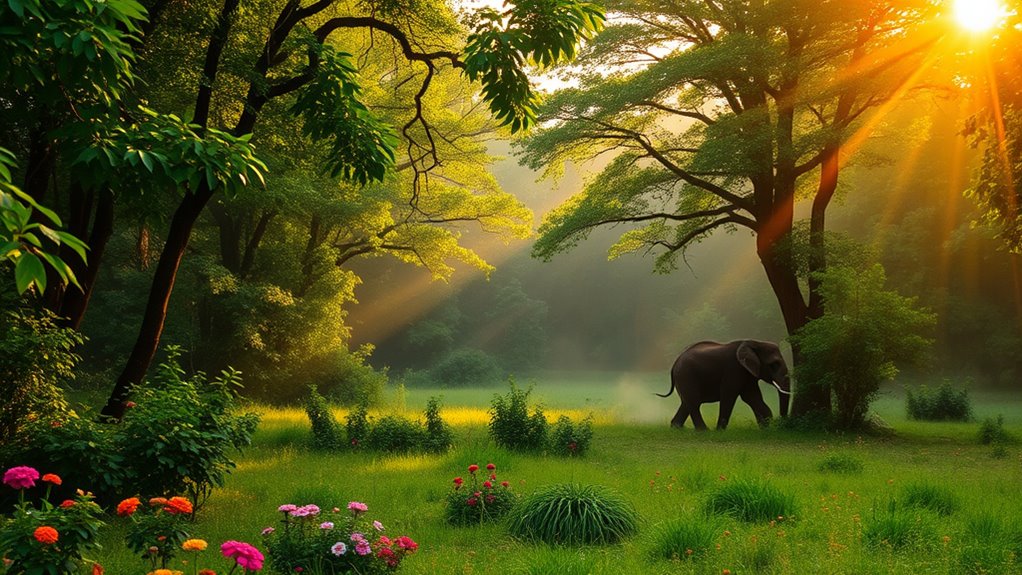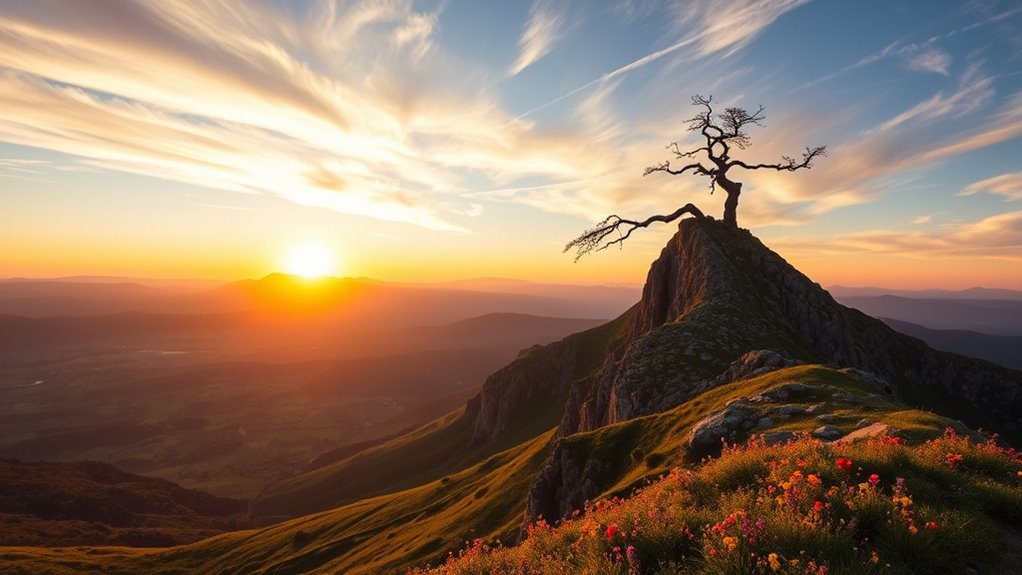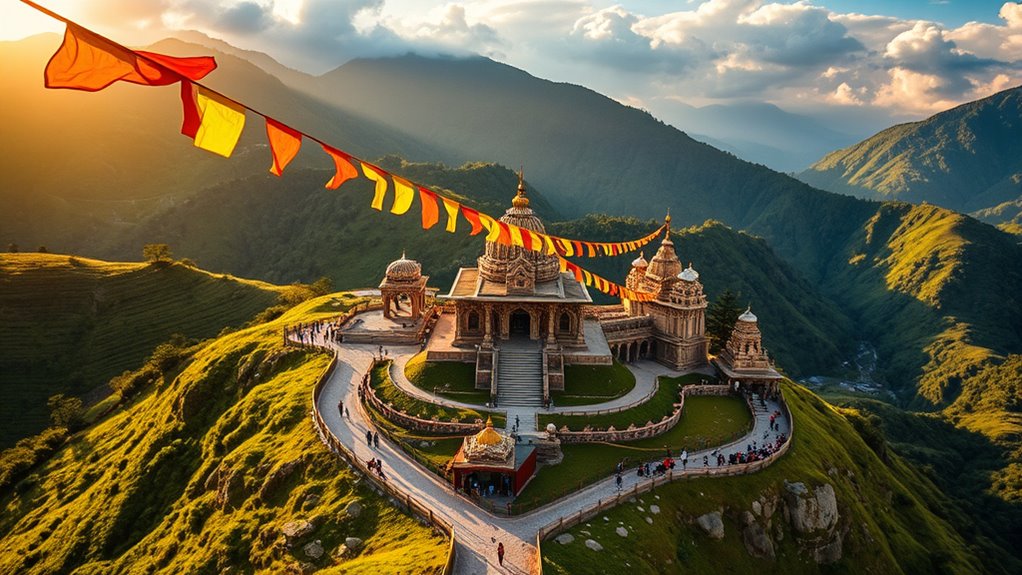
When planning your visit to Jim Corbett National Park, timing can greatly enhance your experience. Each season offers its own unique charm and wildlife opportunities, but winter stands out as the most enchanting. Imagine crisp mornings filled with fog, perfect for spotting elusive tigers and majestic elephants. Yet, there’s more to reflect upon beyond just winter. Let’s explore what each season brings and help you find the best time for your adventure.
Key Takeaways
- Winter (December to February) offers chilly adventures, ideal for early morning safaris to spot tigers and elephants amid magical fog.
- Spring (March to April) showcases blooming flowers and lush greenery, perfect for vibrant photography and increased wildlife activity.
- Summer (May to June) sees heightened wildlife action around waterholes, with fewer crowds providing a more intimate nature experience.
- Monsoon (July to September) brings vibrant greenery and rejuvenated landscapes, though some areas may be off-limits, offering unique charm and serenity.
- Post-Monsoon (October to November) features crisp air and colorful foliage, enhancing wildlife sightings and providing stunning photography opportunities in misty mornings.
Overview of Jim Corbett National Park
Jim Corbett National Park is a stunning sanctuary that showcases the rich biodiversity of India’s northern region. Established in 1936, it holds the title of India’s first national park, originally aimed at protecting the majestic Bengal tiger. When you explore its vast landscapes, you’ll encounter an impressive wildlife diversity, including over 600 species of birds and numerous mammals. This park’s history reflects significant conservation efforts, making it an essential habitat for endangered species. As you hike through the lush forests and open grasslands, you’ll gain a deeper appreciation for the delicate balance of nature that Jim Corbett embodies. Whether you’re a wildlife enthusiast or a casual visitor, every moment spent here is a chance to connect with India’s natural heritage.
Winter Season: December to February
The winter season, from December to February, offers a unique experience for visitors to Jim Corbett National Park. You’ll enjoy chilly adventures while witnessing the vibrant winter wildlife that comes alive during this time. The cool temperatures make it perfect for early morning safaris, where you might spot majestic tigers, playful elephants, and colorful birds.
| Wildlife Activity | Best Time to Spot |
|---|---|
| Tiger Sightings | Early Morning |
| Bird Watching | Late Morning |
| Elephant Herds | Afternoon |
As the fog blankets the park, the scenery transforms into a magical wonderland. Don’t forget to bundle up and embrace the thrill of exploring this stunning landscape in winter!
Spring Season: March to April
As temperatures begin to rise, springtime in Corbett National Park brings a vibrant transformation to the landscape and wildlife. You’ll notice the park bursting with life as blooming flowers and lush greenery create a picturesque setting. This season is perfect for spotting spring wildlife, including various bird species and playful deer. With the animals becoming more active, your chances of witnessing their natural behaviors increase.
Spring photography enthusiasts will love capturing the vivid colors and dynamic scenes, making each moment unforgettable. Early mornings and late afternoons offer the best lighting for your shots. Don’t forget your camera as you explore the trails, and soak in the beauty of Corbett during this enchanting season!
Summer Season: May to June
As temperatures rise in May and June, you’ll notice increased wildlife activity in Jim Corbett. The heat drives animals to waterholes, making it an ideal time for safaris. If you’re keen to spot the park’s diverse wildlife, this summer season is your best bet.
Heat and Wildlife Activity
While summer heat can be intense in Jim Corbett from May to June, it also brings a unique opportunity to observe wildlife activity at its peak. The rising temperatures lead to noticeable changes in wildlife behavior, as animals often seek water sources during the hottest parts of the day. You’ll experience the thrill of spotting animals like elephants and deer congregating near rivers and ponds, making your visit unforgettable.
| Time of Day | Wildlife Activity |
|---|---|
| Early Morning | Active feeding and movement |
| Midday | Resting in shade |
| Late Afternoon | Drinking at water sources |
| Evening | Increased activity |
| Night | Nocturnal species emerge |
These temperature fluctuations create perfect conditions for wildlife watching.
Best Time for Safaris
The summer season from May to June is an ideal time for safaris in Jim Corbett, especially given the heightened wildlife activity during these months. With the hot weather driving animals to water sources, your chances of wildlife sightings notably increase.
Here’s what you can expect during your safari:
- Early morning and late afternoon safari timings are best for spotting animals.
- You’ll likely see elephants, tigers, and deer near waterholes.
- Birdwatching opportunities are abundant as migratory birds flock to the area.
- The lush greenery contrasts beautifully with the dry season landscape.
- Expect fewer crowds, allowing for a more intimate experience with nature.
Monsoon Season: July to September
Although many shy away from visiting Jim Corbett during the monsoon season from July to September, this time of year offers a unique charm that can enhance your experience. The monsoon brings vibrant greenery and rejuvenates the park, creating a picturesque landscape. You’ll find that monsoon wildlife becomes more active, as animals seek food and water sources. Keep your eyes peeled for fascinating bird species that flock to the area, adding to the rich biodiversity. The rainfall effects create a soothing atmosphere, making your safaris feel intimate and magical. While some areas may be off-limits due to safety concerns, the beauty and serenity of Jim Corbett during the monsoon can leave an indelible mark on your adventure.
Post-Monsoon Season: October to November
As the monsoon clouds clear and the landscape transforms, visiting Jim Corbett from October to November is a delightful experience. The park bursts into life, showcasing vibrant autumn foliage and offering fantastic opportunities for wildlife photography.
- Crisp air enhances your outdoor adventures.
- Wildlife becomes more active, making sightings frequent.
- The lush greenery contrasts beautifully with colorful leaves.
- Early mornings provide magical misty views.
- The serene environment encourages peaceful reflection.
This period not only highlights the natural beauty of the park but also invites you to capture stunning images of diverse flora and fauna. So, grab your camera and immerse yourself in this picturesque season at Jim Corbett!
Tips for Visiting Jim Corbett at Different Times of the Year
When planning your visit to Jim Corbett, it’s essential to contemplate the unique experiences each season offers. In winter, dress warmly and arrive early for the best wildlife photography opportunities as animals are more active. Spring is perfect for spotting migratory birds; use safari tips like staying quiet and patient to capture stunning shots. During the summer months, the heat can be intense, so opt for early morning or late afternoon safaris to see animals near waterholes. In the monsoon, the park may close, but if it’s open, enjoy the lush greenery and vibrant wildlife. Always check weather conditions and book your safaris in advance to guarantee an unforgettable experience in this beautiful national park.






